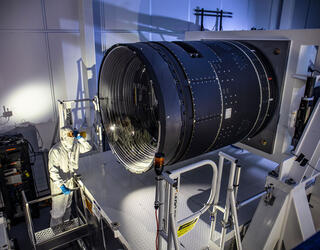Forests cover a third of the world's land surface. Although they provide us with invaluable services, they are now under so much pressure that we are faced with our own contradictions between their sometimes conflicting roles as sanctuaries for biodiversity, or (over)logged sources of...
Article
07.30.2024
For the past 20 years, this specialist in developmental and evolutionary biology has been passionately dedicated to studying a small fish that lives in the waters of Central America. So much so that she took up speleology in order to explore deep caves in...
Article
07.23.2024
Haunted houses, ghosts, spirits… From Mongolia to the United Kingdom, the anthropologist Grégory Delaplace investigates the various ways in which the dead manifest themselves to the living. He takes these “apparitions” seriously, refusing to prejudge whether...
Article
07.22.2024
Our topics
Slideshow
07.12.2024
It took hundreds of scientists worldwide, including several CNRS teams, to produce the world’s largest digital camera, the LSST (Legacy Survey of Space and Time), which has finally arrived in Chile....
Article
06.27.2024
On 22 June, a Chinese Long March 2C rocket launched the SVOM satellite, carrying two French-designed instruments, into orbit. The mission's goals are to investigate the mechanism of gamma-ray...
Article
06.20.2024
Alessandro Morbidelli is a specialist in the evolution and formation of planetary systems, and holds the planetary formation Chair at the Collège de France. The astrophysicist looks back on his...
06.14.2024
The “Sanctuary on the Moon” project, launched nearly ten years ago, aims to send a collection of discs containing a vast body of knowledge and material evidence of human civilisation to the Moon.
Article
04.24.2024
The recent discovery of a binary system containing an extremely rare object, the most massive black hole (apart from SgrA*) ever detected in our Galaxy, calls into question the models for the...
Article
03.27.2024
Galactic archaeology uses state-of-the-art telescopes to reconstruct the history of our Milky Way, from the Big Bang to the present day.
03.13.2024
As opposed to black holes, white holes are thought to eject matter and light while never absorbing any. Detecting these as yet hypothetical objects could not only provide evidence of quantum gravity...
Article
02.12.2024
On 24 September, 2023, material collected three years earlier from the surface of asteroid Bennu was successfully returned to Earth by the OSIRIS-REx mission. Some thirty laboratories around the...
10.17.2023
How do planets form? How did life emerge from lifeless matter? Does it exist elsewhere? These are just some of the questions that the multidisciplinary Origins programme will attempt to answer.
09.15.2023
Following the disappointing results from other candidates for explaining dark matter, a particle hypothesised over 40 years ago, the axion, has come back to the forefront.
Article
07.21.2023
Blind since her teenage years, Wanda Diaz-Merced has developed a technique called “sonification” to convert astrophysical signals into sounds. Building on the success of this impressive tool for...
06.08.2023
Located at an altitude of 2,500 metres on the Bure plateau in the Alps, the Noema international observatory is the most powerful radio telescope in the northern hemisphere. Thanks to the data...














